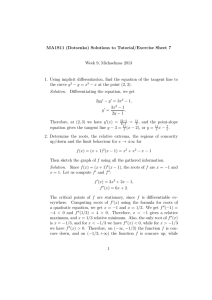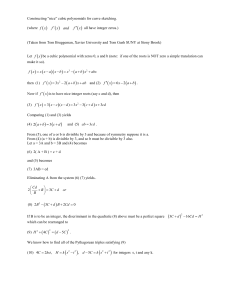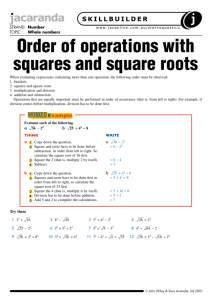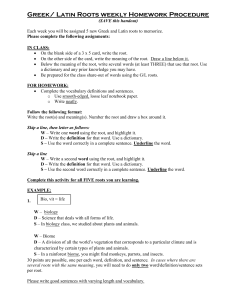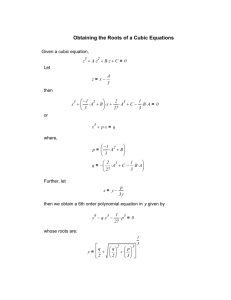49. Use the Closed Interval Method. Solve f ′(x) = 0, where f′(x
advertisement
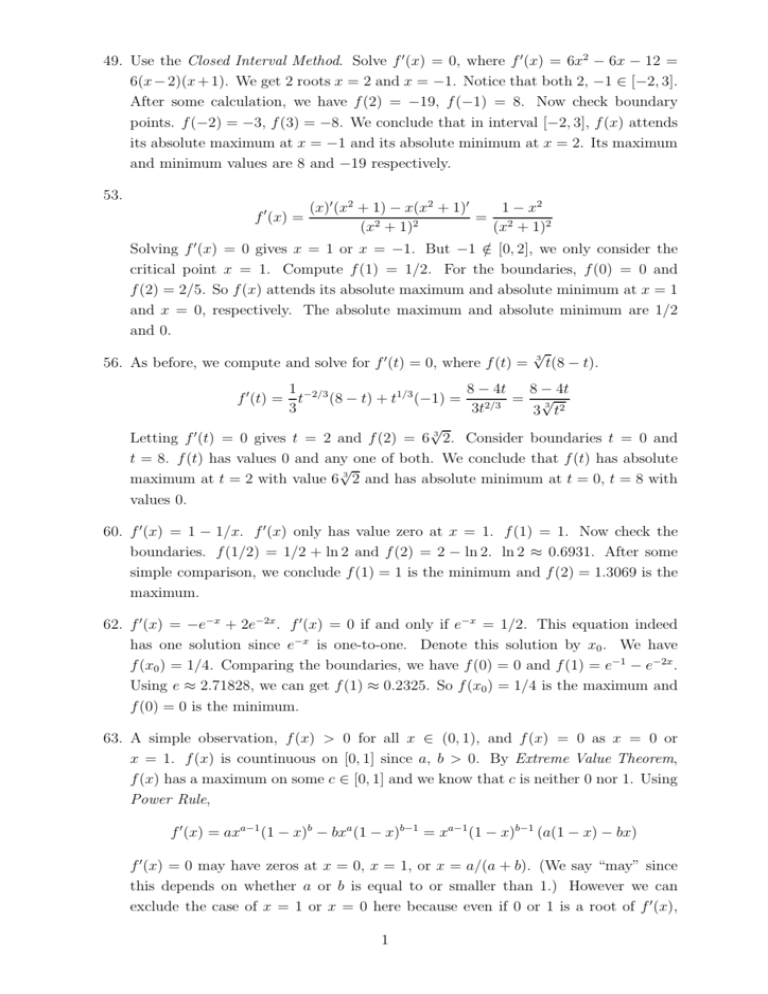
49. Use the Closed Interval Method. Solve f ′ (x) = 0, where f ′ (x) = 6x2 − 6x − 12 = 6(x − 2)(x + 1). We get 2 roots x = 2 and x = −1. Notice that both 2, −1 ∈ [−2, 3]. After some calculation, we have f (2) = −19, f (−1) = 8. Now check boundary points. f (−2) = −3, f (3) = −8. We conclude that in interval [−2, 3], f (x) attends its absolute maximum at x = −1 and its absolute minimum at x = 2. Its maximum and minimum values are 8 and −19 respectively. 53. f ′ (x) = (x)′ (x2 + 1) − x(x2 + 1)′ 1 − x2 = (x2 + 1)2 (x2 + 1)2 Solving f ′ (x) = 0 gives x = 1 or x = −1. But −1 ∈ / [0, 2], we only consider the critical point x = 1. Compute f (1) = 1/2. For the boundaries, f (0) = 0 and f (2) = 2/5. So f (x) attends its absolute maximum and absolute minimum at x = 1 and x = 0, respectively. The absolute maximum and absolute minimum are 1/2 and 0. √ 56. As before, we compute and solve for f ′ (t) = 0, where f (t) = 3 t(8 − t). 1 8 − 4t 8 − 4t = √ f ′ (t) = t−2/3 (8 − t) + t1/3 (−1) = 3 2/3 3 3t 3 t2 √ Letting f ′ (t) = 0 gives t = 2 and f (2) = 6 3 2. Consider boundaries t = 0 and t = 8. f (t) has values 0 and any one of both. We conclude that f (t) has absolute √ maximum at t = 2 with value 6 3 2 and has absolute minimum at t = 0, t = 8 with values 0. 60. f ′ (x) = 1 − 1/x. f ′ (x) only has value zero at x = 1. f (1) = 1. Now check the boundaries. f (1/2) = 1/2 + ln 2 and f (2) = 2 − ln 2. ln 2 ≈ 0.6931. After some simple comparison, we conclude f (1) = 1 is the minimum and f (2) = 1.3069 is the maximum. 62. f ′ (x) = −e−x + 2e−2x . f ′ (x) = 0 if and only if e−x = 1/2. This equation indeed has one solution since e−x is one-to-one. Denote this solution by x0 . We have f (x0 ) = 1/4. Comparing the boundaries, we have f (0) = 0 and f (1) = e−1 − e−2x . Using e ≈ 2.71828, we can get f (1) ≈ 0.2325. So f (x0 ) = 1/4 is the maximum and f (0) = 0 is the minimum. 63. A simple observation, f (x) > 0 for all x ∈ (0, 1), and f (x) = 0 as x = 0 or x = 1. f (x) is countinuous on [0, 1] since a, b > 0. By Extreme Value Theorem, f (x) has a maximum on some c ∈ [0, 1] and we know that c is neither 0 nor 1. Using Power Rule, f ′ (x) = axa−1 (1 − x)b − bxa (1 − x)b−1 = xa−1 (1 − x)b−1 (a(1 − x) − bx) f ′ (x) = 0 may have zeros at x = 0, x = 1, or x = a/(a + b). (We say “may” since this depends on whether a or b is equal to or smaller than 1.) However we can exclude the case of x = 1 or x = 0 here because even if 0 or 1 is a root of f ′ (x), 1 they are impossible to be maximums. So we know the maximum must occur at x = a/(a + b) and a b a a b f = a+b a+b a+b 67. (a) The graph of f (x) is given below. 0.35 0.3 0.25 0.2 0.15 0.1 0.05 0 0 0.2 0.4 0.6 0.8 1 √ Figure 1: f (x) = x x − x2 Notice that f (x) has definition only when the value in the square root is nonnegative, i.e., x − x2 ≥ 0. x − x2 ≥ 0 if and only if 0 ≤ x ≤ 1. The maximum and minimum nearly are 0.32 and 0 by using graph. (b) Using Calculus. f ′ (x) = √ x(1 − 2x) 3x − 4x2 x − x2 + √ = √ 2 x − x2 2 x − x2 f ′ (x) = 0 if and only if x = 3/4 and 3 3√ f = 3 4 16 Since f (x) has value zero both at x = 1 and x = 0. We know that f (x) has a √ maximum value 3 3/16 at x = 3/4 and minimum 0 at both x = 0 and x = 1. 78. (a) In Calculus class, we only consider real functions. Let f (x) = ax3 + bx2 + cx + d, where a, b, c, d ∈ R. f ′ (x) = 3ax2 + 2bx + c. Put D = (2b)2 − 4(3a)(c). f (x) has 2 distinct real roots if D > 0, has a repeated root if D = 0, and has no real roots if D < 0. As an example of 2 critical points, let a = 1/3, b = −1, c = −8, d = 0. f (x) = (1/3)x3 − x2 − 8x. Then f ′ (x) = x2 − 2x − 8. D = (−2)2 − 4(1/3)(−8) > 0, so f ′ (x) has 2 distinct roots. We illustrate this by graph below. As an example for exactly one critical point, let a = 1, b = 0, c = 0, d = 0. f (x) = x3 , and f ′ (x) = 3x2 has only one root at x = 0. We illustrate f (x) below. 2 To complete all cases, consider a = 1, b = 0, c = 1, d = 0. f (x) = x3 + x and f ′ (x) = 3x2 + 1 has no real roots. So f (x) has no critical points for all x. We draw this function below, too. 100 80 60 40 20 0 −20 −40 −4 −2 0 2 4 6 8 Figure 2: f (x) = (1/3)x3 − x2 − 8x 1 0.8 0.6 0.4 0.2 0 −0.2 −0.4 −0.6 −0.8 −1 −1 −0.5 0 0.5 1 Figure 3: f (x) = x3 10 8 6 4 2 0 −2 −4 −6 −8 −10 −2 −1.5 −1 −0.5 0 0.5 1 1.5 2 Figure 4: f (x) = x3 + x (b) By (a), a cube function can have 2, 1, or 0 critical points. 3

